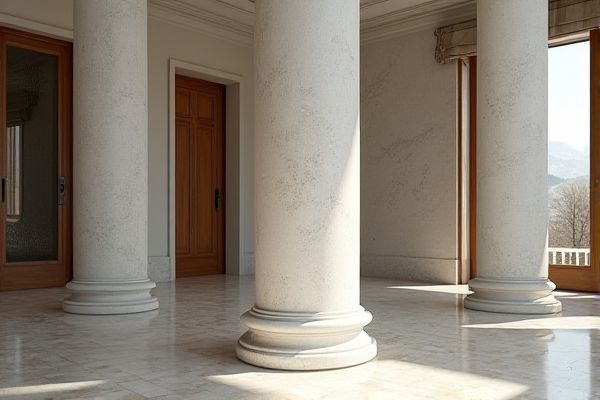
Composite columns offer enhanced strength and durability by combining materials such as steel and concrete, while fiberglass columns are lightweight, corrosion-resistant, and ideal for decorative purposes. Explore the rest of the article to understand which option best suits your construction needs.
Table of Comparison
| Feature | Composite Column | Fiberglass Column |
|---|---|---|
| Material Composition | Combination of materials such as steel and concrete for high strength | Reinforced polymer with glass fibers, lightweight and corrosion-resistant |
| Strength | High load-bearing capacity suitable for structural applications | Moderate strength; mostly for decorative or light structural use |
| Durability | Excellent durability; resistant to fire, weather, and pests | Highly resistant to corrosion, moisture, and chemicals |
| Weight | Heavier due to steel and concrete components | Lightweight, easing transportation and installation |
| Installation | Requires heavy machinery and skilled labor | Easy to install with basic tools |
| Cost | Generally higher due to materials and labor | Cost-effective for decorative and non-structural purposes |
| Typical Applications | Structural columns in buildings, bridges, and industrial frameworks | Decorative columns, lightweight fencing, and facades |
Introduction to Composite Columns and Fiberglass Columns
Composite columns combine steel and concrete to maximize strength, durability, and load-bearing capacity in structural applications. Fiberglass columns, made from reinforced polymer composites, offer corrosion resistance, lightweight properties, and design flexibility for both aesthetic and functional architectural elements. Selecting between these materials depends on project-specific needs such as structural performance, environmental conditions, and maintenance requirements.
Material Composition and Manufacturing Processes
Composite columns consist of high-strength materials such as steel, concrete, and fiber-reinforced polymers, which are combined to enhance load-bearing capacity and durability. Fiberglass columns are primarily made from glass fiber-reinforced plastic (GFRP), utilizing a resin matrix infused with woven glass fibers through processes like filament winding or pultrusion for lightweight and corrosion-resistant structures. The manufacturing of composite columns involves layering or encasing different materials to optimize structural performance, whereas fiberglass columns rely on specialized molding techniques to achieve uniformity and strength.
Structural Strength and Durability Comparison
Composite columns offer superior structural strength due to their high load-bearing capacity and resistance to bending and compression compared to fiberglass columns, which are lighter but less robust under heavy loads. Durability-wise, composite columns excel in harsh environments as they resist corrosion, moisture, and UV damage better than fiberglass, which can degrade over time when exposed to prolonged environmental stress. Your choice between these materials should consider the specific strength requirements and environmental conditions of your project for optimal performance.
Weight and Load-Bearing Capabilities
Composite columns offer a superior load-bearing capacity compared to fiberglass columns due to their integrated materials like steel or concrete. Fiberglass columns are significantly lighter, making them easier to handle and install but generally support less weight. Your choice depends on whether you prioritize structural strength or reduced weight for your project.
Resistance to Weather and Environmental Factors
Composite columns exhibit superior resistance to weather and environmental factors compared to fiberglass columns, as they are engineered with materials that withstand UV radiation, moisture, and temperature fluctuations more effectively. Fiberglass columns may degrade over time when exposed to prolonged sunlight and harsh weather conditions, leading to potential structural weaknesses. Your choice of composite columns ensures longevity and maintained aesthetic appeal in demanding climates.
Installation Methods and Ease of Handling
Composite columns typically offer easier installation methods due to their lightweight and modular design, which allows for quicker assembly and reduced labor costs. Fiberglass columns are also lightweight but may require specialized tools and adhesives, affecting the ease of handling and installation time. Your choice depends on the project's complexity and the availability of skilled installers familiar with each material's specific handling requirements.
Maintenance Requirements and Longevity
Composite columns typically require minimal maintenance due to their resistance to corrosion, rot, and insect damage, ensuring extended durability in various environmental conditions. Fiberglass columns also offer low maintenance demands and excellent weather resistance, but may be more susceptible to UV degradation over time without proper protective finishes. Your choice should consider the specific exposure conditions and maintenance willingness to maximize the service life of the column material.
Cost Analysis: Composite vs Fiberglass Columns
Composite columns generally offer a more cost-effective solution compared to fiberglass columns due to lower material and manufacturing expenses, making them ideal for budget-conscious projects. Fiberglass columns, while more expensive upfront, provide superior durability and resistance to environmental factors, potentially reducing long-term maintenance costs. Evaluating your project's specific budget constraints and lifecycle requirements will help determine which column type delivers the best value.
Aesthetic Options and Customization
Fiberglass columns offer a wide range of aesthetic options and customization, including various colors, textures, and finishes that mimic natural materials like wood and stone without the need for painting or staining. Composite columns also provide customizable design options, often allowing for intricate shapes and sizes, but they typically require additional coatings for color and finish variety. Both materials enable architects and designers to achieve visually appealing, tailored looks for diverse architectural styles, with fiberglass excelling in low-maintenance, durability, and vibrant color retention.
Best Applications and Use Cases
Composite columns excel in high-load structural applications such as commercial buildings, bridges, and industrial facilities due to their high strength-to-weight ratio and fire resistance. Fiberglass columns are ideal for decorative architectural elements, outdoor applications, and environments requiring corrosion resistance, including patios, pergolas, and marine structures. Both materials offer durability, but composite columns focus on structural integrity, while fiberglass columns prioritize aesthetic appeal and weather resistance.
 homyna.com
homyna.com